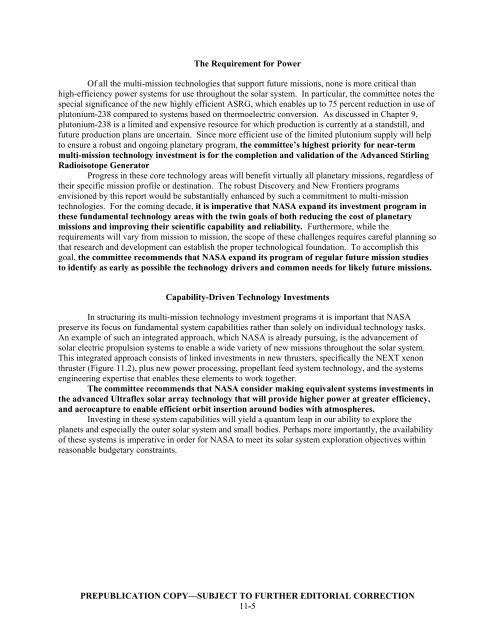Vision and Voyages for Planetary Science in the - Solar System ...
Vision and Voyages for Planetary Science in the - Solar System ...
Vision and Voyages for Planetary Science in the - Solar System ...
You also want an ePaper? Increase the reach of your titles
YUMPU automatically turns print PDFs into web optimized ePapers that Google loves.
The Requirement <strong>for</strong> Power<br />
Of all <strong>the</strong> multi-mission technologies that support future missions, none is more critical than<br />
high-efficiency power systems <strong>for</strong> use throughout <strong>the</strong> solar system. In particular, <strong>the</strong> committee notes <strong>the</strong><br />
special significance of <strong>the</strong> new highly efficient ASRG, which enables up to 75 percent reduction <strong>in</strong> use of<br />
plutonium-238 compared to systems based on <strong>the</strong>rmoelectric conversion. As discussed <strong>in</strong> Chapter 9,<br />
plutonium-238 is a limited <strong>and</strong> expensive resource <strong>for</strong> which production is currently at a st<strong>and</strong>still, <strong>and</strong><br />
future production plans are uncerta<strong>in</strong>. S<strong>in</strong>ce more efficient use of <strong>the</strong> limited plutonium supply will help<br />
to ensure a robust <strong>and</strong> ongo<strong>in</strong>g planetary program, <strong>the</strong> committee’s highest priority <strong>for</strong> near-term<br />
multi-mission technology <strong>in</strong>vestment is <strong>for</strong> <strong>the</strong> completion <strong>and</strong> validation of <strong>the</strong> Advanced Stirl<strong>in</strong>g<br />
Radioisotope Generator<br />
Progress <strong>in</strong> <strong>the</strong>se core technology areas will benefit virtually all planetary missions, regardless of<br />
<strong>the</strong>ir specific mission profile or dest<strong>in</strong>ation. The robust Discovery <strong>and</strong> New Frontiers programs<br />
envisioned by this report would be substantially enhanced by such a commitment to multi-mission<br />
technologies. For <strong>the</strong> com<strong>in</strong>g decade, it is imperative that NASA exp<strong>and</strong> its <strong>in</strong>vestment program <strong>in</strong><br />
<strong>the</strong>se fundamental technology areas with <strong>the</strong> tw<strong>in</strong> goals of both reduc<strong>in</strong>g <strong>the</strong> cost of planetary<br />
missions <strong>and</strong> improv<strong>in</strong>g <strong>the</strong>ir scientific capability <strong>and</strong> reliability. Fur<strong>the</strong>rmore, while <strong>the</strong><br />
requirements will vary from mission to mission, <strong>the</strong> scope of <strong>the</strong>se challenges requires careful plann<strong>in</strong>g so<br />
that research <strong>and</strong> development can establish <strong>the</strong> proper technological foundation. To accomplish this<br />
goal, <strong>the</strong> committee recommends that NASA exp<strong>and</strong> its program of regular future mission studies<br />
to identify as early as possible <strong>the</strong> technology drivers <strong>and</strong> common needs <strong>for</strong> likely future missions.<br />
Capability-Driven Technology Investments<br />
In structur<strong>in</strong>g its multi-mission technology <strong>in</strong>vestment programs it is important that NASA<br />
preserve its focus on fundamental system capabilities ra<strong>the</strong>r than solely on <strong>in</strong>dividual technology tasks.<br />
An example of such an <strong>in</strong>tegrated approach, which NASA is already pursu<strong>in</strong>g, is <strong>the</strong> advancement of<br />
solar electric propulsion systems to enable a wide variety of new missions throughout <strong>the</strong> solar system.<br />
This <strong>in</strong>tegrated approach consists of l<strong>in</strong>ked <strong>in</strong>vestments <strong>in</strong> new thrusters, specifically <strong>the</strong> NEXT xenon<br />
thruster (Figure 11.2), plus new power process<strong>in</strong>g, propellant feed system technology, <strong>and</strong> <strong>the</strong> systems<br />
eng<strong>in</strong>eer<strong>in</strong>g expertise that enables <strong>the</strong>se elements to work toge<strong>the</strong>r.<br />
The committee recommends that NASA consider mak<strong>in</strong>g equivalent systems <strong>in</strong>vestments <strong>in</strong><br />
<strong>the</strong> advanced Ultraflex solar array technology that will provide higher power at greater efficiency,<br />
<strong>and</strong> aerocapture to enable efficient orbit <strong>in</strong>sertion around bodies with atmospheres.<br />
Invest<strong>in</strong>g <strong>in</strong> <strong>the</strong>se system capabilities will yield a quantum leap <strong>in</strong> our ability to explore <strong>the</strong><br />
planets <strong>and</strong> especially <strong>the</strong> outer solar system <strong>and</strong> small bodies. Perhaps more importantly, <strong>the</strong> availability<br />
of <strong>the</strong>se systems is imperative <strong>in</strong> order <strong>for</strong> NASA to meet its solar system exploration objectives with<strong>in</strong><br />
reasonable budgetary constra<strong>in</strong>ts.<br />
PREPUBLICATION COPY—SUBJECT TO FURTHER EDITORIAL CORRECTION<br />
11-5











